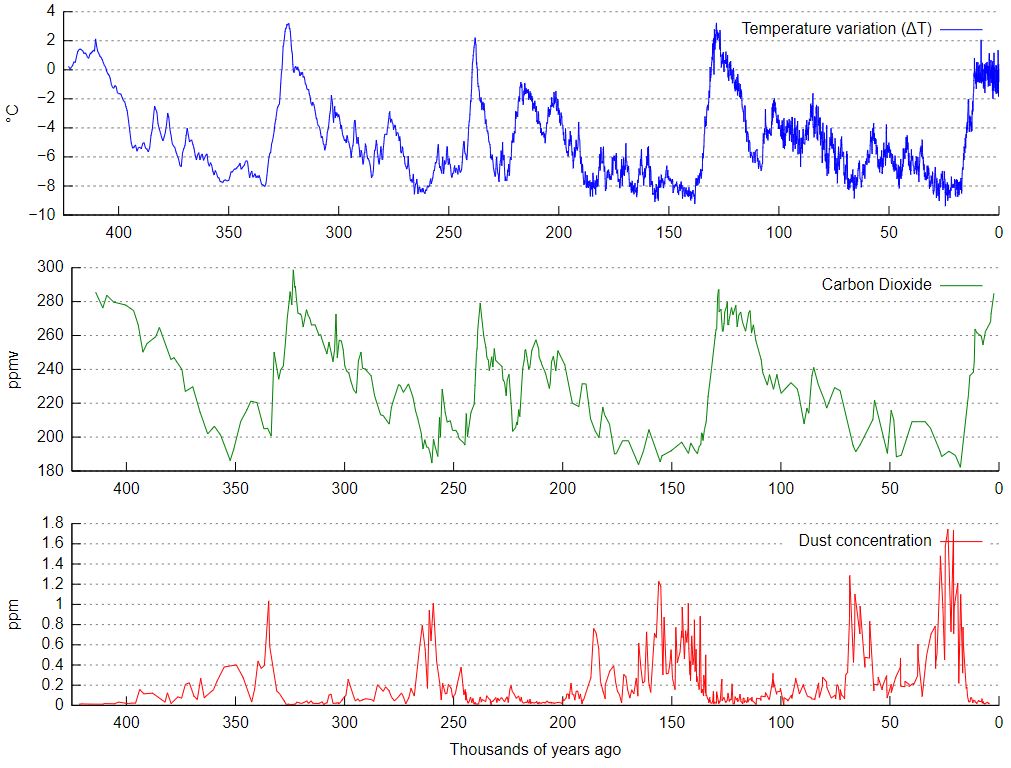Over the past 20 or more years the subject of global warming and climate change have become highly controversial. Many people believe that the Earth’s atmosphere is warming as a consequence of the build-up of greenhouse gases like carbon dioxide, bringing the danger of sea level rise as ice sheets melts. And about as many other people are sceptical about the dangers of warming, and argue that there are actually many benefits consequent on a slight warming of the atmosphere.
But, in addition to this controversy, there is also related questions that accompany the discovery that the Earth has been subjected to long and persistent ice ages in its recent history, and we are at present enjoying a warm 12,000 year interglacial period, during which almost the complete entirety of human civilisation has developed.
However, according to ice core data that has only become available in the past 30 years, these interglacial episodes seldom last longer than a few thousand years before the ice returns:

Shouldn’t we be more worried about the Earth returning to a 100,000 year period of glaciation than we are currently are about global warming? After all, the historical record in the ice cores would seem to be telling us that we are overdue for the return of the ice. And a renewed ice age that sees large areas of the northern hemisphere covered in hundreds or thousands of metres of ice would be far more catastrophic for humanity than sea level rise due to global warming.
The causes of the onset and retreat of ice ages are not well understood. They are variously ascribed to changes in the Earth’s orbit (Milankovitch cycles), varying greenhouse gas concentrations, changes in ocean current circulation, variations in the intensity of solar radiation, vulcanism, and asteroid impacts. Despite this, there have been several confident predictions that our current interglacial will be very long-lasting:
Humanity has become a geological force that is able to suppress the beginning of the next ice age, a study now published in the renowned scientific journal Nature shows. Cracking the code of glacial inception, scientists of the Potsdam Institute for Climate Impact Research found the relation of insolation and CO2 concentration in the atmosphere to be the key criterion to explain the last eight glacial cycles in Earth history. At the same time their results illustrate that even moderate human interference with the planet’s natural carbon balance might postpone the next glacial inception by 100.000 years.
However, if the causes of ice ages are not well understood, why should we suppose that current CO2 concentrations in the atmosphere are sufficient to delay the onset of the next ice age by 100,000 years?
40 years ago I used to be a research assistant working with electronic conductive heat flow simulation models of buildings, and so I have some interest in heat flow. I’ve wanted to construct my own computer climate simulation model so that I could study for myself the processes taking place in the atmosphere. But it seems that the general circulation models used in climate science require supercomputers of a kind to which I don’t have access. It has always seemed very important to me that people should be able to build models of physical processes in order to study them.
If anyone is to ever understand anything, they must first build a model of it.
So if you are to understand boats, you must build model boats. And if you are to understand planes, you must build model aircraft. And if you are to understand architecture, you must build model buildings And if you are to understand the Solar System, you must build a model of the Sun with all the planets going round it. And if you are to understand warfare, you must build armies of toy soldiers.
These models are usually much smaller than the full size objects they represent. And they are usually quicker to create. And they allow the problems of the full size objects to be anticipated. If your model boat sinks, or your model plane doesn’t fly, it’s unlikely that the full size boat or plane will do much better. And if your model boat floats, and your model plane flies, there’s a good chance that their full size versions will float and fly too.
If you have no model, you probably won’t know what you’re doing. You’ll just be guessing.
So if you are to understand the world’s climate, you must build climate models. And if you are to understand weather, you must build weather models. And if you are to understand geology, you must build geological models. And if you are to model glaciers, you must build model glaciers.
And if you’re building a model, you will also be trying to find out something. If you’re building a model boat, you’ll be want ing to know if it floats. And if it has sails, you’ll want to know whether it won’t capsize in a strong wind.
In this blog I’m going to build a model of the world. It’s going to be a very simple model. And it may not tell me very much. But it’ll probably tell me more than I can find out by just guessing.
You must be logged in to post a comment.